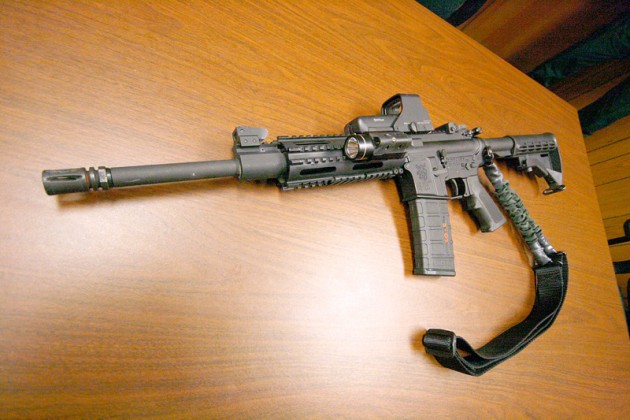Comparable to SWAT

Two minutes.
That’s how long it takes a specially trained USF officer to cross campus during a crisis. The training is part of a new University Police program aimed at protecting students from extreme situations, such as a campus shooting.
Tactical Response is for the type of campus emergency that a SWAT team would normally take care of — one that requires specially trained officers, equipment to protect them and a quick response, said Lt. Chris Daniel, the program’s commander.
In an emergency situation, the Tactical Response team would be the first wave of responders, UP Chief Thomas Longo said.
“The key is to get cops in as quickly as possible and locate the shooter,” he said.
The tactical officers, however, lack sufficient equipment because of budget restrictions. That’s why the program has taken two years to become a reality.
UP officers said they are concerned for student safety and want to invest in the program — so much, in fact, that some have used their own money to help fund it.
“Officers spent several hundred dollars out of their own pockets to pay for training,” Longo said.
UP — which is under the Division of Public Safety — has a budget of $3.5 million, which comes from the division’s overall budget of $5.3 million. UP was not given extra money for the program because the division doesn’t have enough money to spare for it, said Bruce Benson, vice president of the Division of Public Safety.
“We would like to give them more money for the program, but at the same time, we are facing further reductions,” he said.
There is not much money available for equipment, Longo said. Since the program has no budget or funds, the department has difficulty paying for training supplies and tactical equipment. The program, however, has the basic equipment that’s needed, Benson said.
For example, instead of having their own individually fitted tactical vests, the officers share generic-sized vests.
“What they have is functional and safe,” he said.
If an emergency situation were to happen right now, officers would have to respond without head protection or a proper tactical vest, Longo said.
The total cost of equipment would be about $3,725 per officer, said tactical officer and medical specialist Frank Adams. This would include a protective vest with ceramic heart-protecting plates, a microphone and radio designed for officers to communicate in fast-paced situations, a rifle, a helmet and a tactical belt.
Tactical belts are more lightweight and flexible than regular police belts, with a larger handcuff pouch. A holster and weapon with a flashlight attachment are also included. The latter is important for situations in dark rooms, Adams said.
Because of the lack of funds, the only equipment available to officers is uniforms, modified tactical belts, generic-sized vests and six rifles. The modified tactical belts are standard officer belts that have been modified to be more lightweight.
Helmets are one of the most-needed tools because they can take direct rifle strikes and protect officers looking around corners, Longo said.
“I’m really proud of the creative efforts to acquire equipment,” Daniel said. “There is a 10-to-1 chance of encountering an active shooter in a building, so equipment is critical. It’s a dangerous situation.”
Though USF has never had an active shooter situation, there have been homicides on campus.
“An incident is always possible,” said certified active shooter instructor Sgt. Robert Finch. “It’s just a matter of when. We want to make sure no one loses their life.”
Each officer’s training took 84 hours total, spread from February to August. It consisted of rifle handling, close quarters instruction and active shooter instruction, Finch said. Eight officers finished training in August and two more have been trained for all but rifle handling.
During training, officers underwent a realistic exercise with an active shooter, Finch said. Student volunteers played injured and panic-stricken victims, some with fake injuries and blood. The air was filled with gunpowder, and a man shot blanks to give the experience a real-life feel.
Longo said he wanted to implement a program like this in 2006 during his first year at USF, but the program didn’t take shape until this year.
Gov. Charlie Crist signed an executive order just after the Virginia Tech shooting in 2007 that established a task force to determine Florida universities’ preparation for an active shooter situation.
“A sufficient force of police officers equipped to handle rapidly unfolding violent situations must be in place,” stated the task force’s recommendations.
USF police officers interested in becoming tactical officers volunteered for the program and were chosen based on a number of factors, like physical fitness and experience, Daniel said.
“Each person brings a certain different skill to the team,” he said.
The officers chosen have diverse backgrounds, including medical knowledge and combat experience.
One to two tactical officers will be on duty for each shift, but Longo said they would like to have three per shift, if possible.
“We want our students to know that we’re here if anything happens,” Daniel said. “We’ve gone the extra mile.”
UCF is the only school in Florida to employ a similar program. They have had a SWAT team for several years.






